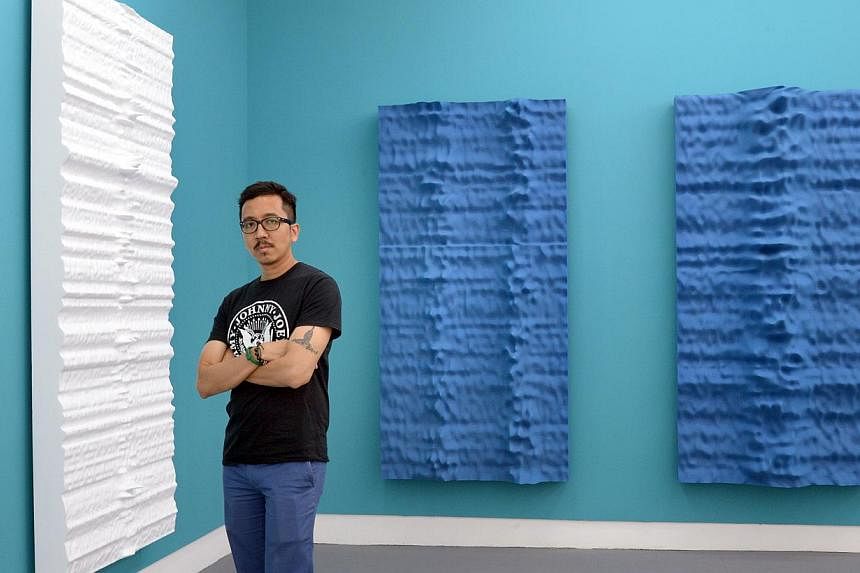Layered, hide-and-seek surfaces pop up in many of Singapore painter Jeremy Sharma's new artworks made of high-density foam. Expanding on some of the pieces he had shown at the Singapore Biennale, he continues with his creative experimentations with foam and delivers stunning visual results.
These new works are juxtaposed with some of his earlier works awash in grey. Closer inspection of what appears to be a uniform series of grey paintings reveals subtle differences in the application of the paint.
Viewed together, the foam and grey works show the transition he has made both in the use of unconventional artistic materials and subjects.
Mode Change, his solo exhibition running at Galerie Michael Janssen in Gillman Barracks till June 13, features 17 works - nine grey paintings and eight foam works, priced between $8,000 and $28,000.
The new foam paintings, some of which are larger than a single bed mattress, have interesting titles such as Tahata, Ubuntu, Parkes and Vela.
When asked about these as well as the title of the exhibition, the articulate Sharma, 36, tells Life! about his almost accidental entry into the world of art.
"I did not choose art. I fell into it. I was a science student. I went to art school wanting to be a graphic designer," he says.
This explains his fascination not just with unconventional titles but uncoventional materials too.
He has drawn upon data sets collected from a scientist and incorporated that into his new artworks.
Knowing this and re-visiting the works does give them a very space-like feel.
He adds that in radio astronomy and the study of pulsars (dead stars), "a mode change occurs when the shape of a pulse changes at intervals and returns to its original shape".
The first mode change of a pulsar was identified in 1970. This was also the time when there were shifts happening and questions raised about modern art and its very aesthetics.
"I had been thinking about it for sometime and experimenting with materials," he says.
He calls foam "a very unusual material", one he was drawn to because it offered a three-dimensionality in its form and allowed him to create artworks that effectively blur the lines between painting and sculptural objects. The material also lends to deep explorations of time, light and matter.
The six large eight-feet-tall foam works are based on wave forms and radiographs of dying stars collected from scientists. Using these as a starting point, he found a way of using data and "translating it into 3-D column slabs of ridges, peaks and valleys".
In the gallery space, the dark, reflective surfaces of the grey paintings offer a creative contrast to the white and blue undulations of the foam works, the very creation of which is perfectly planned.
Mode Change then shifts effortlessly between "the very modes of painting", says Sharma.
The question that he seeks to ask is "what constitutes a work of art. What constitutes a painting? Does it need to be limited by an easel?"
Clearly not.
Sharma, who is married and has two children aged three and one, teaches at the Lasalle College of the Arts.
He says he deliberately avoids canvas and oil paint in his practice because he wants to question the very limits of materials and how contemporary art can be made.
His inspiration continues to come from varied sources - newspapers, television, the Internet and ideas from memory.
He says: "I am inspired by our fragmented world where we obtain all kinds of information everywhere."
When asked if he is happy with the result of his recent creative experiments and whether he will stick with foam, he responds: "I am never happy with what I do. I want to always do something a little more demanding, a little more rigorous. I want to continue testing myself and the limits of various materials available. I am interested in these tensions - of whether it will work or not."
It shows in the very art he creates.

